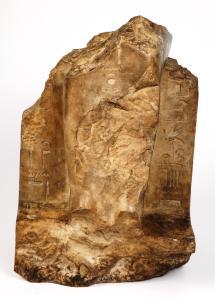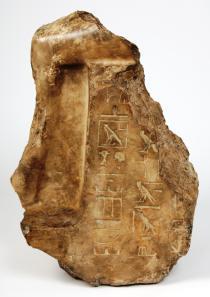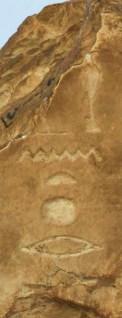Campbell / Manchester Museum
Source - http://egyptmanchester.wordpress.com/2014/01/29/object-biography-15-a-previously-unidentified-statue-of-senenmut-acc-no-4624/

Acc. no. 4624. Photos copyright Manchester Museum
Our fragment (Acc. no. 4624) came to the Manchester Museum from the excavations of Edouard Naville at the site of Deir el-Bahri between 1894 and 1907. A more precise provenance for the piece or when exactly it entered the collection is not known. The fragment is 48.5cm high and 31cm wide, made of indurated limestone, and depicts the lower portion of a seated figure at about half lifesize. It is badly damaged but still carries hieroglyphic text on the sides of the seat, base and over the knees. Interestingly, the seat retains an artisan’s red ink guidelines for the inscription. Traces remain of blue pigment within individual hieroglyphic signs, implying that the statue was not, however, left unfinished.

The identity of the individual represented is recorded in our catalogue – based on hieroglyphs on the base – as ‘the priest of Amun, Userhat’ and the piece is there dated to the Middle Kingdom. I had often wondered who this mysterious priest Userhat was. Because the favour formula only begins to appear on elite statues at the end of the Middle Kingdom, I speculated if this was one of the first examples of it. And given that the formula usually only appeared on sculptures of the very high elite at this time, I wondered why a simple ‘priest of Amun’ had been so favoured.
I thought no more about the fragment until the visit last Autumn of Prof. Rainer Hannig, of the University of Marburg. During a very genial and informative discussion with Rainer, I pointed the piece out and – almost as an afterthought – he noted that the hieroglyphs identifying the owner (Hm-nTr n imn wsr-hAt) could be read as a single title: ‘the priest of Amun-Userhat (a name of the sacred barque of Amun at Karnak)’, a title known to be held by only one person: Senenmut – high official under Queen Hatshepsut and one of the most well-known individuals from ancient Egypt.

It was with considerable anticipation that I checked the other titles on the statue (‘nobleman’, ‘governor’, and the slightly more unusual ‘overseer of the priests of Montu’) and found that each was attested for Senenmut. Knowing that the statue was from Deir el-Bahri, the site of Hatshepsut’s famous mortuary temple, I became really rather excited. On closer inspection of the statue itself, it was apparent that the lap of the figure seemed to rise somewhat before the mid-thigh break and no hands were visible. Could it be that this was a broken example of Senenmut in his innovative pose with Hatshepsut’s daughter, Neferure, bound within his cloak on his lap? Perhaps most revealing of all, upon close examination of the remains of the favour formula which had first attracted my attention I noticed that the statue was given as favour not by a ‘king’ at all – but by a ‘god’s wife’. There is only oneexample known to me of this variant of the favour formula, and that statue (Cairo CG 42117) belongs to Senenmut. Whether this ‘god’s wife’ is Hatshepsut herself or her daughter is unclear.

Detail of favour formula. The tops of the ‘Hmt nTr‘ signs can just be made out.
Six more statues of the total of 25 known for Senenmut carry the statement that they were ‘given as favour of the king’. In the inscriptions of another (CG 42214), Senenmut makes the following unusual – and somewhat touching – appeal to Queen Hatshepsut, explaining perhaps why he possessed so many statues:
Grant that there be commanded for this your humble servant the causing that there be made for me many statues of every kind of precious hard stone for the temple of Amun in Karnak and for every place wherein the majesty of this god proceeds, as [was done] for every favoured one of the past; then they shall be in the following of the statues of Your Majesty in this temple.
Senenmut hoped that by dedicating a range of sculptures – many of them innovative in their motifs, and set up in different locations – he would increase the chances of his memory lasting for eternity. Others, it seems, had different ideas. There is evidence that some – though not all – of Senenmut’s images were maliciously attacked. Perhaps this was carried out by those with a unknown person grudge against Senenmut? Perhaps by those who thought his relationship with the Queen inappropriate? Or perhaps by those that hated Hatshepsut herself? Perhaps even by later people for whom the very idea of a female pharaoh was anathema? Whatever the motivation, maybe this is the reason that the Manchester fragment is so badly damaged.
Senenmut’s life has inspired more scholarly and popular writing than almost any other non-royal from Pharaonic times. I am quite sure that this bashed-up fragment, which has lain unrecognised in Manchester for over a century, represents the twenty-sixth attested statue for Senenmut. Information from its texts and archaeological context may well add important details to the Senenmut story, illustrating that exciting new finds await discovery in even the most supposedly well-known collections.
See further:
- Delvaux, L. 2008. Donné en récompense de la part du roi‖ (djw m Hswt nt xr nsw), Unpublished PhD dissertation: Strasbourg.
- Dorman, P. 1988. The Monuments of Senenmut: Problems in Historical Methodology, London.
- Meyer, C. 1982. Senenmut: Eine prosopographische Untersuchung, Hamburg.
- Price, C. 2011. Materiality, Archaism and Formula: The Conceptualisation of the Non-Royal Statue during the Egyptian Late Period (c. 750-30 BC), Unpublished PhD dissertation: Liverpool.
A full publication of the Manchester fragment is currently in preparation.